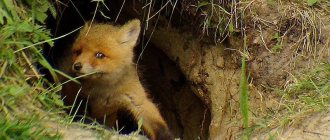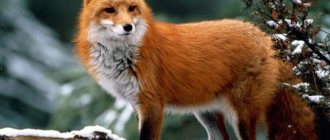The arctic fox or polar fox (lat. Vulpes lagopus) is a predator belonging to the canine family. Some scientists distinguish the genus Arctic foxes, but usually the mammals are classified as foxes.
There are several subspecies of arctic foxes: Mednovsky, brown and Icelandic foxes, white foxes. The Mednovsky subspecies can be distinguished by its blue fur. The brown arctic fox is larger than its counterparts and has brownish fur.
Origin of the species and description
Photo: Arctic fox
Arctic foxes belong to the canine family, but the genus of arctic foxes is represented by only one single species. These animals are often called foxes, or more precisely, polar, arctic or white foxes. Arctic foxes are divided into two types based on the color of their fur.
Video: Arctic fox
White Arctic foxes change the thickness and color of their fur throughout the year. In winter, they wear the most fluffy and thick snow-white fur coat - this is what is most valued in fur markets. After a long spring molt, they become browner and less fluffy.
But blue foxes generally have a fur color that is far from white. All year round they wear a brownish, brownish or gray fur coat. It changes its thickness depending on the season.
Nature has rewarded them with very thick fur and undercoat. The climate in which they live is so harsh that the only way to survive is a year-round warm fur coat and fat reserves. Moreover, animals have hair even on their paws, right on the pads of their toes. It is for this that arctic foxes got their name, because in translation it means “hare’s paw.”
Content
If a person is going to start breeding representatives of a species, great attention must be paid to the conditions of detention.
The animals are housed in cages made of galvanized steel. This greatly simplifies caring for animals.
The dimensions of the structure are:
- Length at least 3 m;
- Width not less than 1 m;
- Height – about 1 m.
The structure cannot be placed on bare ground. The dwelling in which the arctic fox will be located must stand on legs.
Note ! The cages contain animals that are raised for their fur. However, the arctic fox can also be just a friend. If the baby was born and raised in captivity, he will be able to live in an apartment or on a person’s plot like an ordinary dog.
The Arctic fox can become a true friend. Raised in captivity, he will behave like a normal dog
Young animals can be placed in a cage in pairs, but for an adult it is better not to put a neighbor, but you also cannot leave the animal alone.
Over time, he may become skittish and his appetite may decrease. The cells must be arranged so that representatives of the species constantly feel the presence of their fellow creatures.
Appearance and features
Photo: Arctic fox animal
At first glance, Arctic foxes are most similar to foxes, only they are white. These animals are also shorter in stature: their legs are shorter than those of ordinary foxes, and therefore they look slightly mundane or understated. Arctic foxes are small animals, the largest individuals reach 9 kg, but this is rare. Arctic foxes are mostly three- or four-kilogram small animals. Externally, fur makes them a little bulkier.
The average body length is about fifty to seventy centimeters, and the animals are about thirty centimeters in height. This disproportionate ratio is a bit like the body shape of a dachshund. This body structure allows the animal to spend heat more economically, and it is located lower to the ground, where there is less wind.
Arctic foxes have a very beautiful tail. It grows up to thirty centimeters in length, and is covered with fur as lush and thick as the body.
The animal's muzzle differs from that of a fox; it is short and wide, but very compact, and the ears are also short and rounded. Such a difference is necessary in living conditions; it eliminates the possibility of frostbite on a part of the body that is too long. So in arctic foxes everything is compact and covered with a fur coat, and they also have well-developed sense organs: good hearing and an excellent sense of smell.
The eyes of arctic foxes have an interesting device: they are covered with a protective layer from too bright light, which can be reflected from snowy surfaces on clear days. However, arctic foxes are not endowed with acute vision.
Where does the arctic fox live?
Photo: Arctic fox in the tundra
Arctic foxes inhabit the North Pole and the tundra and forest-tundra latitudes around it. Moreover, they live on all northern islands, continents and even drifting ice floes. White Arctic foxes mainly inhabit the territories of the contingents: North America, northern Europe and Asia. But blue foxes prefer the adjacent islands, and on the continents they can be found quite rarely.
Arctic foxes are adapted to such a harsh northern climate, polar nights and frosts. However, they are dependent on food. And, in the event of a shortage of prey, they can change their place of residence, traveling vast distances. The arctic fox is able to run almost a hundred kilometers in a day with its shortened legs on permafrost and snow. So the animals are not tied to a specific habitat and are always ready to change the place to a more nourishing one.
According to their habitat, it is customary to specifically distinguish several subspecies of the Arctic fox:
- Arctic foxes living on the island of Iceland, besides them there are no other mammals there, they are given the name Alopex lagopus fuliginosus.
- Arctic foxes of Bering Island. This subspecies stands out among its relatives with its dark fur. Not everyone knows such arctic foxes, because they are not white at all, but closer to black. In addition, this subspecies includes the largest individuals. Their name is Alopex lagopus beringensis.
- One of the rarest subspecies is the Mednovsky Arctic fox, from the name of its habitat, Medny Island. Of these, only about a hundred individuals remain.
Male and female blue Mednovsky fox: main differences
Males of the Mednovsky Arctic fox are always larger in size than females, which is the only main manifestation of sexual dimorphism for them. Otherwise, there are no differences in the appearance of representatives of the different sexes of this species.
What does the arctic fox eat?
Photo: Arctic fox in winter
It’s difficult for such northern inhabitants to find food. But they are not picky about food and are ready to get enough of what they have so as not to die. Arctic foxes hunt small rodents, mainly lemmings. They are also attracted to bird eggs and the chicks themselves. Baby sea animals also often become their prey. They are capable of killing a small seal or walrus.
Common food for Arctic foxes in the summer are some types of fish, shellfish, crustaceans and even sea urchins. The arctic fox also consumes almost everything from plant food. There is little vegetation in the tundra, so there is no choice. The diet includes berries, scanty plants, soft branches of bushes, and algae.
They cannot cope with large animals, however, if the animal died a natural death or was killed by another, larger animal, then the arctic foxes will not disdain to eat the remains. It happens that arctic foxes specially attach themselves to bears or wolves in order to finish off their prey.
In general, the winter diet of arctic foxes mostly consists of carrion, which makes carrion more accessible. Arctic foxes eat dead marine mammals: whales, walruses, fur seals, sea otters, seals and some others. They can even satisfy their severe hunger with ungulate droppings. The dead individuals of the arctic foxes themselves also serve as food for their closest brothers. In this sense, these animals have developed cannibalism.
Nutrition
The black arctic fox can eat any food. The animal's diet consists of small rodents, lemmings , and birds.
The animal happily eats fish that have been washed ashore by the tide.
The plump Arctic fox shown in the photo above resembles a gray cloud and looks very comical
The animal does not disdain carrion. Representatives follow polar bears, eating the remains of seal meat after them.
However, such proximity is fraught with consequences. If the polar bear cannot get food, the animal itself will be the prey, which will not be able to compete with the giant predator.
The “white fox” can empty traps set by humans. In summer, a representative of the species tries to store excess food for the winter.
It is well known that arctic foxes living in coastal areas happily eat bird eggs and the small chicks themselves, left unattended by their parents.
The Arctic fox seems to be very happy with the hunt
Features of character and lifestyle
Photo: Arctic fox
In summer, the arctic fox is active for a long time - almost around the clock, which is associated with the long duration of daylight hours. At this time of year, he is constantly looking for the food needed to feed his family. During the summer, the arctic fox must accumulate fat and nutrients in its body, otherwise it will not survive the cold winter. In autumn and winter, the Arctic fox prefers to go out in search of food at night.
In summer, animals rest mainly in their burrows, but sometimes they can relax in the open air. But in winter, the arctic fox prefers to dig a new den right in a snowdrift and hide there. He can hide for several days in a row from a snowstorm or during severe frosts.
In general, Arctic foxes are very well adapted to tundra conditions. But even despite being adapted to harsh conditions, every autumn animals wander along sea coasts or rivers towards the south? to the most conformal regions, which may be several hundred kilometers away. In the spring they gradually return back.
The family way of life is very similar to that of a fox. They can also stay solitary in winter, although very often they gather in groups of several around large prey. And in the spring they form pairs, and then raise their offspring through joint efforts.
By nature, Arctic foxes are cautious and prefer not to take risks unnecessarily. At the same time, they are characterized by persistence and even arrogance. When meeting larger predators, they do not run away, but simply move away to some distance, and if possible, they try to snatch a piece of its prey. In general, arctic foxes combine both strategies for finding food - active hunting and freeloading.
Very often you can see a polar bear eating, and at this time he is surrounded by several Arctic foxes, waiting for their turn. In those places where arctic foxes are not hunted, the animals are not afraid of humans and calmly approach his home. They are quite inventive. For example, hungry Arctic foxes may enter human homes or barns, where they often steal food. They may also steal food from dogs.
Social structure and reproduction
Photo: Arctic fox cub
Arctic foxes are monogamous animals. They almost always form strong pairs and live in families. Each family usually includes two adults - a male and a female, their cubs of the current brood in the amount of three to ten puppies, and sometimes several more young females from the previous brood. Some animals can live in colonies of several families. Very often, females raise offspring. Sometimes two or three families can unite in neighboring burrows connected by a passage.
Typically, the area of habitat of an arctic fox family ranges from 2 to 30 square kilometers. However, in hungry years, polar foxes can run far beyond the boundaries of their territory, up to tens of kilometers.
Before having offspring, adult Arctic foxes dig minks for themselves. A place for a burrow is always chosen in elevated places, since on the plain there is a risk of flooding with melt water. Usually, burrows are dug in soft soil, among stones, which are needed for protection. A well-located burrow, suitable for breeding, can be passed on by Arctic foxes from generation to generation. But more often the old hole is abandoned by the new generation, and a new hole is built nearby. It is often connected to the parental home by a tunnel. Sometimes you can find entire labyrinths, reaching 50-60 entrances.
These animals reach sexual maturity at nine or eleven months. In March or early April, female Arctic foxes begin to estrus, which usually lasts no more than two weeks. At this time, a period called hunting takes place. During the period when the female can become pregnant, fights occur between rival males. By fighting, they draw the female’s attention to themselves. A male's flirting can also occur in another way: he runs in front of his chosen one with a stick, a bone or another object in his teeth.
Pregnancy usually lasts 52 days, but this value can range from 49 to 56 days. Towards the end, when the pregnant female feels that she will give birth soon, usually this happens within 2 weeks, she begins to prepare her home - she digs a new hole, clears the old one of leaves. If for some reason there is no hole, then she can give birth in the bushes. From the moment the female gives birth to her cubs, the male arctic fox becomes the only breadwinner for the entire family.
The female takes full care of the offspring. For about 10 weeks, small puppies feed on milk. Then, having already reached three to four weeks of age, they gradually begin to leave the hole. Their mother not only feeds them, but also teaches them to hunt, teaches them to survive frosts by digging holes in snowdrifts.
Raising offspring
Newborn puppies open their eyes already on the 9th day. The cubs grow very quickly. By the age of six months, they already reach the size of their parents.
Babies grow up very quickly and leave their parents' hole
In summer, a family of arctic foxes consists of 2-6 individuals and occupies a vast habitat area. A married couple and their children can own a plot of up to 30 square meters. km.
Representatives of the species can travel as far as 10 km for food. Females often raise several offspring, and several families can settle in one burrow.
The number of animals in some populations reaches 40 young individuals. There are 10-20% more males in a family than females.
Natural enemies of arctic foxes
Photo: Arctic fox
Despite the fact that the Arctic fox itself is a predator, this animal also has enemies. Cubs are especially at risk. Arctic foxes can be hunted by wolverines, raccoon dogs, foxes and wolves. Occasionally, a polar bear may also attack, although more often the arctic fox is not of interest to it due to its small size.
But young Arctic foxes can become prey for birds of prey, such as:
- White Owl;
- golden eagle;
- skua;
- white-tailed eagle;
- crow;
- owl;
- large species of gulls.
But more often, polar foxes die not as victims of predators, but from starvation due to a lack of food resources. Therefore, under natural conditions, the amount of animal mortality (as well as reproduction) varies greatly from year to year. Also limiting factors are diseases, mainly scabies, distemper, arctic encephalitis and helminthiases.
For the Arctic fox, direct competitors for food are animals such as ermine or weasel. But these species are small in number and therefore do not cause significant damage to the arctic fox. Also, over the past decades, a shift in the southern border of the arctic fox’s habitat to the north has been noted. A number of scientists believe this is a consequence of the colonization of the forest-tundra strip by foxes. But there is also an opinion that the shift is due to the effect of heat on the ground and soil, its moisture, which changes the duration of snow cover, the microclimate of burrows and changes in the distribution of food supply.
Population and species status
Photo: Arctic fox Red Book
The number of Arctic foxes is subject to strong fluctuations depending on the availability of food resources, especially lemmings. Animal migrations also have a great influence on population numbers. Just as every autumn the animals inhabiting the tundra begin to roam along the sea coasts, as well as river valleys towards the south, and return back in the spring, not all animals survive the nomadism, and some of them die, especially in hungry years.
In the tundra zone in different years, the number can range from several tens of thousands of individuals to several hundred thousand animals. Arctic foxes are most numerous in the Bolshezemelsky, Yenisei, Ustyansky, Yamal, and Lena tundras.
In the past, people hunted Arctic foxes a lot because of their beautiful fur coat. This led to a significant decline in numbers. Therefore, today the hunting season is strictly regulated - it is limited to the autumn period, and only adult individuals can be hunted. And the smallest and most endangered, with a very small number, the Commander subspecies of the blue fox (also known as the Mednovsky arctic fox) has the status of an endangered species and is listed in the Red Book of Russia.











